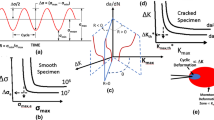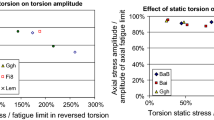Abstract
In recent years we have developed several new methods for predicting the endurance limits of components which fail by fatigue from stress concentrations. These methods were arrived at by improving two existing theoretical models: the critical volume (process zone) concept and the equivalent stress-intensity concept. Our approach renders these methods suitable for application to components of any three-dimensional geometry and allows the necessary material constants to be calculated from well-known existing material properties: the plain-specimen endurance limit and the crackpropagation threshold. This paper summarises the results of an extensive validation programme involving both notched specimens and industrial components. A high degree of reliability was obtained, with predictions of fatigue limit loads or stresses falling almost always within 20% of the experimental values. In the latter half of the paper we consider the mechanistic basis of these theories, and present a number of ideas in which these essentially empirical models are linked to the underlying processes of fatigue crack initiation, short crack growth and long crack growth. These mechanistic models are able to give some useful insights, but as yet we are not able to completely explain the excellent predictive success of these methods.
Access this chapter
Tax calculation will be finalised at checkout
Purchases are for personal use only
Preview
Unable to display preview. Download preview PDF.
Similar content being viewed by others
References
Smith RA and Miller KJ (1978) Prediction of fatigue regimes in notched components. lnt. J.Mech.Sci. 20, 201–206.
Westergaard HM (1939) Bearing pressures and cracks. Trans.ASME 61 A49–A53.
Taylor D, Zhou W, Ciepalowicz AJ and Devlukia J (1999) Mixed mode fatigue from stress concentrations; an approach based on equivalent stress intensity. Int.J.Fatigue 21, 173–178.
ElHaddad MH, Dowling NF, Topper TH and Smith KN (1980) J integral applications for short fatigue cracks at notches. lnt.J.Fract. 16, 15–24.
Peterson RE (1959) Notch sensitivity. In Metal Fatigue (Ed. G. Sines& J.L. Waisman) McGraw Hill (New York) 293–306
Neuber H (1958) Theory of notch stresses. Publ. Springer, Berlin.
Siebel E and Stieler M (1955) Dissimilar stress distributions and cyclic loading. Z.Ver. Deutsch. Ing. 97, 121–131.
Taylor D (1999) Geometrical effects in fatigue: a unifying theoretical model Int.J.Fatigue 21, 413–420
Tanaka K (1983) Engineering formulae for fatigue strength reduction due to crack-like notches. Int. J. Fracture 22, R39–R45.
Taylor D and Wang G (2000) The validation of some methods of notch fatigue analysis. Fatigue and Fracture of Engineering Materials and Structures (In Press).
Klesnil M and Lucas P (1980) Fatigue of metallic materials. Publ. Elsevier.
Taylor D, Ciepalowicz AJ, Rogers P and Devlukia J (1997) Prediction of fatigue failure in a crankshaft using the technique of crack modelling. Fatigue and Fracture of Engineering Materials and Structures 20, 13–21.
Taylor D (1996) Crack modelling: a technique for the fatigue design of components. Engineering Failure Analysis 3, 129–136.
Taylor D and Wang G (2000) Component design: the interface between threshold and endurance limit, ASTM STP 1372 Fatigue crack growth thresholds, endurance limits and design, Eds Newman Piascik, ASTM 2000 (In Press).
Lukas P, Kunz L, Weiss B and Stickler R (1986) Non-damaging notches in fatigue. Fatigue Frac. Engng Mater. Struct. 9, 195–204.
Tanaka K, and Nakai Y (1983) Propagation and non-propagation of short fatigue cracks at a sharp notch. Fatigue Fract. Engng Mater. Struct. 6, 315–327.
Hartranft RJ and Sih GC (1973) Methods of analysis and solutions of crack problems. Ed.G.C.Sih, Publ.Noordhoff, Holland.
O’Donoghue PE, Atluri SN and Pipkins DS (1995) Computational strategies for fatigue crack growth in three dimensions with application to aircraft components. Eng.Fract.Mech. 52, 51–64.
Murakami Y (1987) Stress intensity factors handbook. Publ.Pergamon (UK).
Taylor D and O’Donnell M (1995) Notch geometry effects in fatigue, a conservative design approach. Journal of Engineering Failure Analysis 1 (1995) 275–287.
Author information
Authors and Affiliations
Editor information
Editors and Affiliations
Rights and permissions
Copyright information
© 2001 Springer Science+Business Media Dordrecht
About this chapter
Cite this chapter
Taylor, D., Wang, G. (2001). The Critical Volume Method in Fatigue Analysis. In: Pluvinage, G., Gjonaj, M. (eds) Notch Effects in Fatigue and Fracture. NATO Science Series, vol 11. Springer, Dordrecht. https://doi.org/10.1007/978-94-010-0880-8_12
Download citation
DOI: https://doi.org/10.1007/978-94-010-0880-8_12
Publisher Name: Springer, Dordrecht
Print ISBN: 978-0-7923-6842-7
Online ISBN: 978-94-010-0880-8
eBook Packages: Springer Book Archive




